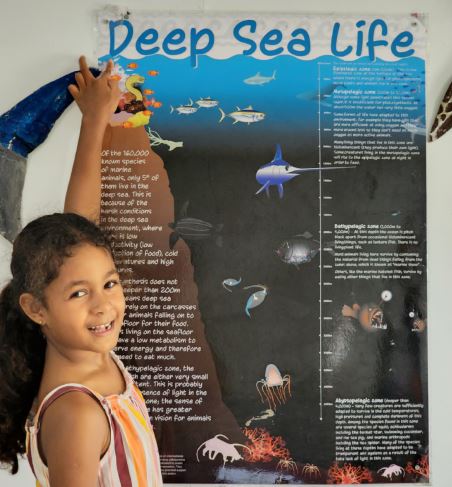Mysteries of the deep
Saturday 21 January 2023 | Written by Te Ipukarea Society | Published in Environment, National

The under explored deep sea has many mysteries that needs to be better understood. Te Ipukarea Society/23012042
Do you ever ponder on what lives down in the mysterious deep sea? Covering such a vast area, who knows what great wonders can be found deep down below?
About 4000 to 6000 metres below sea level is a unique environment called the abyssopelagic zone.
Life down at these deep dark depths has had to adapt to extreme conditions, from high pressure, to complete darkness, food shortages, cold water temperatures and a lack of oxygen.
At such extreme conditions it may seem unlivable. But through millions of years of evolution, life has adapted to living in these conditions.
Discoveries have included bacteria that are new to science, as well as tiny organisms that use bioluminescence to light up the darkness.
The list goes on to include recent discoveries of the abyssal octopus, anemones, deep sea jelly, along with potentially 1.5 million more species still waiting to be found.
Life and activity found here is very slow. Species move slower than life found in shallower waters because of the extreme pressures experienced. Many creatures have adapted to being transparent and eyeless due to the total lack of sunlight and instead rely on other senses.
Food is dependent on the availability of ‘marine snow’, organic matter that sinks through the depths to the ocean floor. The remains of large animal carcasses such as whales that sink to the floor are also a source of food for these deep sea creatures.
From what little science we know, deep sea life is slow growing, with low reproduction rates as they have lived in an undisturbed stable ecosystem for millions of years.
This makes them particularly vulnerable and prone to the slightest change of conditions in their deep-sea environment.
On top of providing habitat for such unique life, our deep sea also plays a significant role in keeping our planet cool by storing large amounts of carbon dioxide. Our oceans really do give back to us!
Sadly, today, our ocean is currently undergoing a lot of stress due to increased industrial development and activity to satisfy our ever growing appetite for food, resources, energy, wealth and convenience.
Some of the stresses our ocean faces right now include overfishing, pollution and climate change.
These pressures are having a negative impact on our seas, upsetting our ocean’s balance, impacting its ability to provide food for us and to regulate our planet’s temperature.
Potential new pressures our deep sea life may encounter are on the horizon.
With growing interest in deep sea mining for nodules, understanding these impacts and whether these are impacts we are willing to accept needs to be properly investigated and discussed amongst our community.
A significant amount of time is still needed for thorough research to answer these very questions.
Time and effort could also be spent on considering alternative more sustainable solutions to seabed mining.
These possibilities could include concepts around establishing a ‘circular economy’ where wasted metal, especially that in our landfills, is recycled as opposed to mining new metals that take millions of years to form.
Research into alternative materials for the transition to a green economy has already identified safer options than these deep sea metals, and more are being developed all the time.
How our deep sea responds to change and what purpose deep sea life plays in the wider picture are just some of the mysteries of the deep still waiting to be better understood.



















































